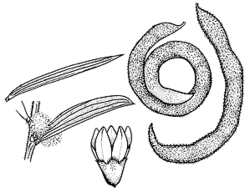Common name: woolly wattle, hairy wattle
Acacia lanigera A.Cunn. APNI* Synonyms: Racosperma lanigerum (A.Cunn.) Pedley APNI*

Description: Erect or spreading shrub to 2 m high, sometimes taller; bark grey; branchlets angled and ridged towards apices, hairy.
Phyllodes ± rigid, straight to slightly curved, usually narrowly elliptic to linear-elliptic, 2–7 cm long, 2–8 mm wide, hairy or glabrous, with 2–4 main (and sometimes other less prominent) longitudinal veins and usually anastomosing veins between, apex acute to sometimes obtuse with a mucro, often pungent; 1 small gland 0–13 mm from base; pulvinus < 2 mm long.
Inflorescences simple, 1–4 in axil of phyllodes; peduncles 1–10 mm long, hairy to glabrous; heads globose to ovoid, 15–30-flowered, 5–9 mm diam., bright yellow. Sepals united for more than half their length.
Pods curved to openly once-coiled, raised over seeds, straight-sided to irregularly slightly constricted between seeds, to 10 cm long, 4–6 mm wide, leathery, whitish-woolly to villous; seeds longitudinal; funicle folded, arilate.
Flowering: May–October
Distribution and occurrence: east from Albury and south from Coonabarabran area. Grows in woodland and dry sclerophyll forest, in poor gravelly and sandy soils.
NSW subdivisions: SC, CT, ST, NWS, CWS, SWS
Other Australian states: Vic.
The name refers to the woolly indumentum of the plant. Intermediates occur between Acacia lanigera and A. venulosa.
Text by P.G. Kodela
Taxon concept: P.G. Kodela & G.J. Harden (2002)
| | Key to the varieties | |
| 1 | Peduncles 1–5 mm long, glabrous to hairy; phyllodes narrow-elliptic or linear-elliptic with gland mostly 3.5–13 mm above pulvinus, anastomoses occasional to numerous. | var. lanigera |
| Peduncles 5–10 mm long, more or less glabrous; phyllodes narrow-elliptic with gland at or near base, anastomoses absent to few. | var. gracilipes |
APNI* Provides a link to the Australian Plant Name Index (hosted by the Australian National Botanic Gardens) for comprehensive bibliographic data
***The AVH map option provides a detailed interactive Australia wide distribution map drawn from collections held by all major Australian herbaria participating in the Australian Virtual Herbarium project.
|


